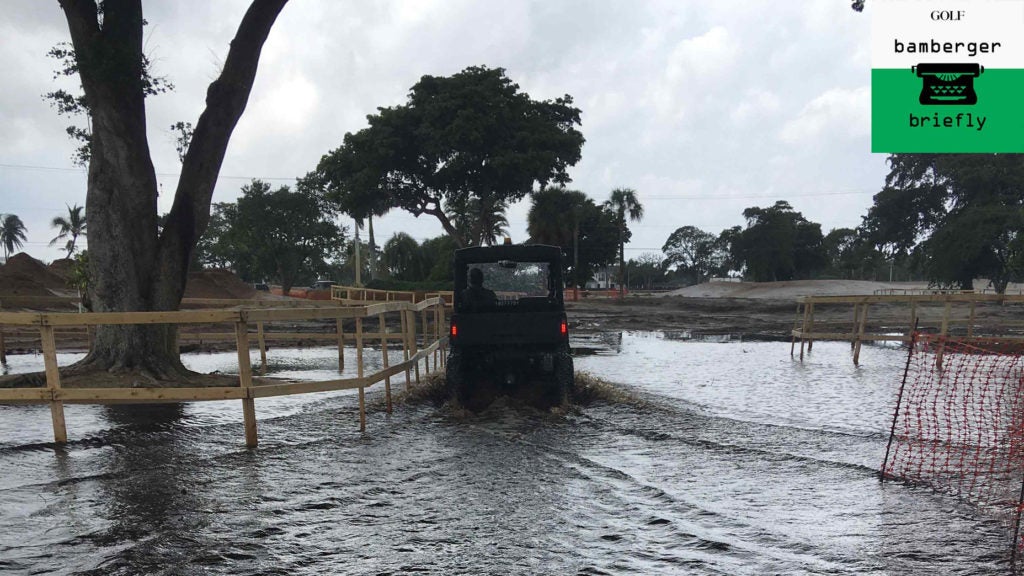Michael Bamberger is back on the road, keeping two club lengths from his sources. This is the third installment in a five-part Bamberger Briefly series from South Florida, about golf’s return to action.
FORT LAUDERDALE, Fla. — On Tuesday afternoon I had about as much fun as I have ever had on a golf course without hitting a shot or seeing a single shot played. My friend Rees Jones, the golf course architect, gave me a tour of one of his father’s best-known courses, the Coral Ridge Country Club, which opened in 1954. Talk about mid-century modern.
The course does not have a blade of grass on it right now. Rees and a shaper, a general manager and several construction overlords — the team — were touring a 140-acre sandbox with white PVC pipes with green tops and red tops to mark future greens and tee boxes. I have been to courses under renovation before, but never at such a primitive moment. The whole thing just screamed playtime.
I have never been able to keep track of Rees’s age. I think he’s 12.
I’ll get to the fun-and-games here in a second, but first the backstory. Coral Ridge is a family country club. Big pool. Big tennis program. Twenty-seven holes of golf. Low-slung elegant clubhouse. Not preppy. More like established, comfortable, secure. Even in these uncertain times.
There are ladies playing cards, in normal times. (Not now. The clubhouse is closed.) Uniformed course workers with their names on their shirts. Tall drinks and big portions. On the course, you’ll find classic Robert Trent Jones landing-strip tee boxes, long enough for a Kennedy family touch football game. Also, RTJ kidney-shaped greens, hard by a pond, here and there. You’re in America now, South Florida-style.
But over the years, nature and golf carts contrived to render the course dead flat. Rees’s job, or one of them, is to give his ancestral course, the actual playing surfaces, shapes. He’s giving it swales and humps and life.
It’s subtle work, but a massive, fast project and the club is spending millions. It is not looking to get the U.S. Open. Coral Ridge is looking to make the course more interesting and fun for the golfers upon it, members and guests, and to draw new members and new guests. The circle of life, club-style. There was never a thought of pulling the plug on the project, which started in mid-March, just as the pandemic was becoming the talk of the nation. American golf is on a spending spree! No, that’s not true. But Coral Ridge is bullish about its future and golf’s future. The course will open for play again in November.
South Florida has been getting soaked for a while now, as often happens this time of year. When I arrived, the club manager said he had a cart for me. (No sharing.) But it wasn’t a cart. It was some kind of diesel-powered all-terrain vehicle from Apocalypse Now. This thing rumbled. I was in a parade of these forest-green trucks, going through brown standing water nearly three-feet deep, up and down beige sand hills, straight through giant mud pits. A good time. Nobody had an iPad.
I remember when Ted Oh played in the 1993 U.S. Open at Baltusrol as a 16-year-old. He came into the press tent and somebody asked him what drew him to golf. Driving the carts, he said. I get that now more than ever. A monsoon visited us. Rees was soaked. We were all soaked. Nobody cared. The rain was warm.
Rees was telling the fellas what he liked, what he was looking for. “I can see the course,” he told me. “I can see exactly how it will play.” His sand is the sculptor’s clay. Every architect wants to work on a sandy site like this. That’s the dream. That’s golf’s past.
Rees is interesting. He’s the son of a famous architect and he went to Yale. He knows everybody and he belongs to various hushed-voice clubs. On Tuesday, he was wearing white socklets with the Maidstone logo on them. (He’s a member there. East Hampton, L.I.) He was wearing a Breakers hotel hat and belt (he designed one course there and renovated the other, beside the hotel. Palm Beach, Fla.) He was wearing a Coral Ridge shirt. But the course-building business is a working-class one, and Rees speaks in the language of his craft. His manner is always thoughtful, but also simple and direct. The architect is an artist, an engineer, a team manager — and a workingman. Rees is a gent. That is, he knows how to treat people.
But more than anything, there’s a lot of kid in him. I drove in Rees’s wake, and in the wake of his colleagues. There were no instructions, no warnings, no rules, no lectures. Just golf-course talk. Yes, this is their work. This is how they earn their livelihoods. But I wasn’t fooled. This was recess. Playtime.
Michael Bamberger welcomes your comments at Michael_Bamberger@GOLF.com.
